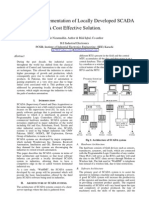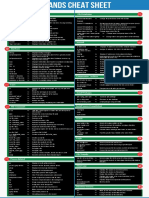SCADA Overview
What is SCADA.............................................................................................................................................2
Analyzing SCADA data.................................................................................................................................2
Integrate SCADA with Other Systems..........................................................................................................2
Tools for Consuming Data from SCADA.......................................................................................................3
Building Model............................................................................................................................................4
�What is SCADA
SCADA stands for Supervisory Control and Data Acquisition, which is a system used for monitoring and
controlling industrial processes.
SCADA systems typically involve a network of sensors, controllers, and other devices that collect and
transmit data about the industrial processes to a central computer system. The central system then
processes the data and provides a graphical user interface for operators to monitor the processes and
make adjustments as needed.
SCADA systems can be used for a wide variety of applications, including monitoring and controlling
power grids, water treatment facilities, oil and gas pipelines, and manufacturing processes.
Analyzing SCADA data
Analyzing SCADA data involves processing and interpreting the data collected from the sensors and
controllers in a SCADA system. Here are some steps to analyze SCADA data:
Identify the relevant data points: Determine which data points are important for monitoring and
controlling the industrial process. This can include measurements such as temperature, pressure, flow
rate, or power consumption.
Collect the data: The SCADA system will continuously collect data from the sensors and controllers,
typically at regular intervals. This data can be stored in a database or analyzed in real-time.
Analyze data trends: Use the SCADA software to visualize and analyze data trends over time. This can
help identify patterns or anomalies that may indicate problems with the industrial process.
Generate reports: Use the SCADA software to generate reports that summarize the data collected by
the system. These reports can be used to identify trends, track performance, and identify areas for
improvement.
Set alarms and alerts: Use the SCADA software to set alarms and alerts based on predefined thresholds
or conditions. This can help notify operators of potential issues before they become problems.
Integrate with other systems: SCADA data can be integrated with other systems such as maintenance
management, enterprise resource planning (ERP), or supply chain management (SCM) systems to
improve efficiency and optimize performance.
�Integrate SCADA with Other Systems
Identify the systems to integrate: Determine which systems can benefit from SCADA data integration.
This can include maintenance management, enterprise resource planning (ERP), supply chain
management (SCM), or other systems.
Determine the integration method: Decide on the integration method based on the systems being
integrated. This can include using APIs, web services, or middleware to transfer data between systems.
Establish communication protocols: Define communication protocols between the SCADA system and
the other systems. This can include setting up data exchange formats, security protocols, and
authentication methods.
Map data fields: Map the data fields between the SCADA system and the other systems to ensure that
data is transferred accurately and efficiently. This involves identifying corresponding data fields in each
system and ensuring that they are mapped correctly.
Implement the integration: Implement the integration by configuring the SCADA system and the other
systems to communicate with each other. This may involve developing custom software or using pre-
built integration tools.
Test and refine the integration: Test the integration to ensure that data is being transferred correctly
and that the integrated systems are functioning properly. Refine the integration as needed to improve
performance and efficiency.
Tools for Consuming Data from SCADA
Apache Kafka: Apache Kafka is an open-source platform for streaming data that can be used to collect,
process, and analyze data from SCADA systems. It is scalable and reliable and can handle high-volume
data streams.
MQTT: MQTT (Message Queuing Telemetry Transport) is a lightweight messaging protocol that is
commonly used in industrial IoT applications. It can be used to stream data from SCADA systems to
other applications, such as dashboards or data visualization tools.
AWS IoT: AWS IoT is a cloud-based platform that can be used to collect and analyze data from SCADA
systems. It provides tools for data collection, processing, and storage, as well as machine learning
algorithms for predictive analytics.
Microsoft Azure IoT Hub: Microsoft Azure IoT Hub is a cloud-based platform that can be used to stream
data from SCADA systems to other applications, such as dashboards or data visualization tools. It
provides tools for data processing, storage, and analysis, as well as machine learning algorithms for
predictive analytics.
�Google Cloud IoT: Google Cloud IoT is a platform that can be used to stream data from SCADA systems
to other applications, such as dashboards or data visualization tools. It provides tools for data
processing, storage, and analysis, as well as machine learning algorithms for predictive analytics.
OpenSCADA: OpenSCADA is a free, open-source SCADA system that is designed to monitor and control
industrial processes. It includes a web-based HMI, data logging, and alarm management features.
Ignition Edge: Ignition Edge is an open-source SCADA system that is designed for edge computing. It can
be used to collect, process, and analyze data from SCADA systems and other devices, and can be
customized to meet specific needs.
Mango Automation: Mango Automation is an open-source SCADA system that is designed to monitor
and control industrial processes. It includes a web-based HMI, data logging, and alarm management
features, and can be customized to meet specific needs.
Building Model
Define the problem: Identify the specific problem that you want to solve using the SCADA data. This
could be to predict future failures, optimize energy consumption, or improve production efficiency,
among other things.
Gather and preprocess the data: Collect the necessary SCADA data and preprocess it by cleaning,
filtering, and normalizing it. This may involve removing outliers, dealing with missing data, and
converting data to a consistent format.
Choose a modeling technique: Choose a modeling technique that is appropriate for the specific problem
you are trying to solve. This could include techniques such as regression analysis, neural networks,
decision trees, or clustering.
Build the model: Use the chosen modeling technique to build a model using the preprocessed SCADA
data. This involves defining the model parameters, training the model, and validating the model using
appropriate metrics.
Evaluate the model: Evaluate the performance of the model using appropriate metrics, such as
accuracy, precision, recall, or F1 score. Use this evaluation to refine the model and make necessary
adjustments.
Deploy and monitor the model: Deploy the model in the production environment and monitor its
performance over time. This may involve updating the model as new data becomes available or
adjusting the model parameters based on changing conditions.
Building models using SCADA data requires planning, data preprocessing, and selection of appropriate
modeling techniques. It's important to have a clear understanding of the problem being addressed and
to carefully evaluate the performance of the model to ensure that it meets the needs of the
organization.























































































